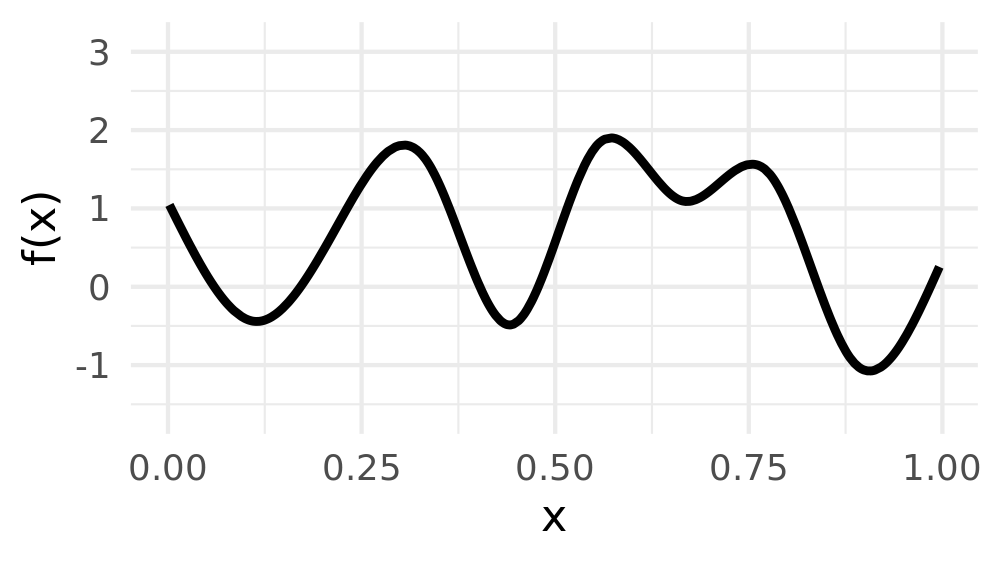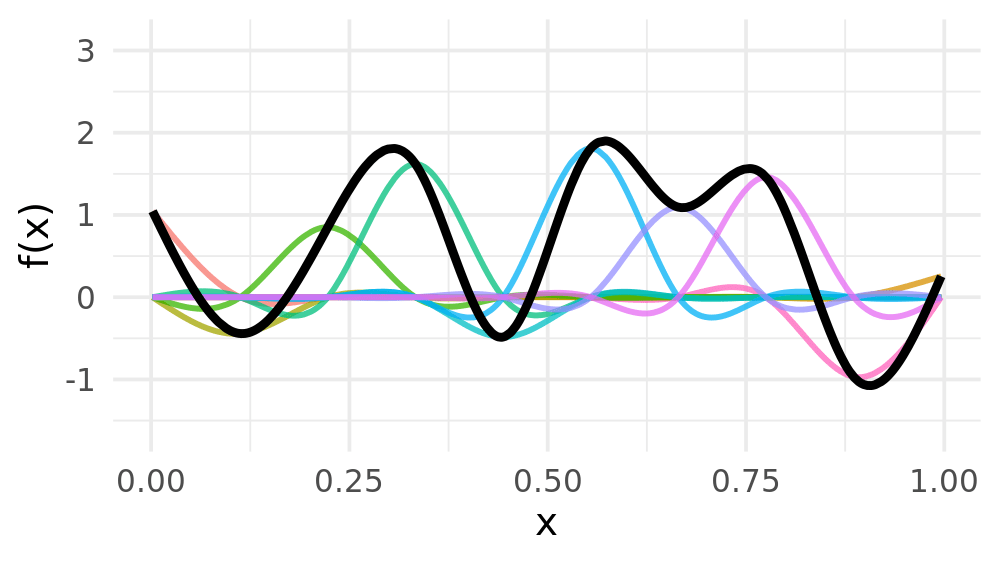Generalized Additive Models with R and mgcv
Gavin Simpson
January 3, 2022
Today's topics
What are GAMs?
How to fit GAMs in R with mgcv
Examples
Motivating example
HadCRUT4 time series
Hadley Centre NH temperature record ensemble
How would you model the trend in these data?
Linear Models
yi∼N(μi,σ2)
μi=β0+β1x1i+β2x2i+⋯+βjxji
Assumptions
- linear effects of covariates are good approximation of the true effects
- conditional on the values of covariates, yi|X∼N(0,σ2)
- this implies all observations have the same variance
- yi|X are independent
An additive model address the first of these
Why bother with anything more complex?
Is this linear?
Polynomials perhaps…
Polynomials perhaps…
We can keep on adding ever more powers of x to the model — model selection problem
Runge phenomenon — oscillations at the edges of an interval — means simply moving to higher-order polynomials doesn't always improve accuracy
GAMs offer a solution
HadCRUT data set
## Load Datatmpf <- tempfile()curl_download("https://www.metoffice.gov.uk/hadobs/hadcrut4/data/current/time_series/HadCRUT.4.6.0.0.annual_nh.txt", tmpf)gtemp <- read.table(tmpf, colClasses = rep("numeric", 12))[, 1:2] # only want some of the variablesnames(gtemp) <- c("Year", "Temperature")gtemp <- as_tibble(gtemp)HadCRUT data set
gtemp## # A tibble: 172 × 2## Year Temperature## <dbl> <dbl>## 1 1850 NA## 2 1851 NA## 3 1852 NA## 4 1853 NA## 5 1854 NA## 6 1855 NA## 7 1856 NA## 8 1857 NA## 9 1858 NA## 10 1859 NA## # … with 162 more rowsFitting a GAM
library('mgcv')m <- gam(Temperature ~ s(Year), data = gtemp, method = 'REML')summary(m)## ## Family: gaussian ## Link function: identity ## ## Formula:## Temperature ~ s(Year)## ## Parametric coefficients:## Estimate Std. Error t value Pr(>|t|) ## (Intercept) -0.020523 0.009733 -2.109 0.0365 *## ---## Signif. codes: 0 '***' 0.001 '**' 0.01 '*' 0.05 '.' 0.1 ' ' 1## ## Approximate significance of smooth terms:## edf Ref.df F p-value ## s(Year) 7.838 8.65 145 <2e-16 ***## ---## Signif. codes: 0 '***' 0.001 '**' 0.01 '*' 0.05 '.' 0.1 ' ' 1## ## R-sq.(adj) = 0.88 Deviance explained = 88.5%## -REML = -91.196 Scale est. = 0.016294 n = 172Fitted GAM
GAMs
GAMs are an intermediate-complexity model
- can learn from data without needing to be informed by the user
- remain interpretable because we can visualize the fitted features
How is a GAM different?
In LM we model the mean of data as a sum of linear terms:
yi=β0+∑jβjxji+ϵi
A GAM is a sum of smooth functions or smooths
yi=β0+∑jsj(xji)+ϵi
where ϵi∼N(0,σ2), yi∼Normal (for now)
Call the above equation the linear predictor in both cases
Fitting a GAM in R
model <- gam(y ~ s(x1) + s(x2) + te(x3, x4), # formuala describing model data = my_data_frame, # your data method = 'REML', # or 'ML' family = gaussian) # or something more exotics() terms are smooths of one or more variables
te() terms are the smooth equivalent of main effects + interactions
How did gam() know?
Wiggly things

GAMs use splines to represent the non-linear relationships between covariates, here x, and the response variable on the y axis.
Basis expansions
In the polynomial models we used a polynomial basis expansion of x
- x0=1 — the model constant term
- x1=x — linear term
- x2
- x3
- …
Splines
Splines are functions composed of simpler functions
Simpler functions are basis functions & the set of basis functions is a basis
When we model using splines, each basis function bk has a coefficient βk
Resultant spline is a the sum of these weighted basis functions, evaluated at the values of x
s(x)=K∑k=1βkbk(x)
Splines formed from basis functions
Splines are built up from basis functions
Here I'm showing a cubic regression spline basis with 10 knots/functions
We weight each basis function to get a spline. Here all the basisi functions have the same weight so they would fit a horizontal line
Weight basis functions ⇨ spline

But if we choose different weights we get more wiggly spline
Each of the splines I showed you earlier are all generated from the same basis functions but using different weights
How do GAMs learn from data?
How does this help us learn from data?
Here I'm showing a simulated data set, where the data are drawn from the orange functions, with noise. We want to learn the orange function from the data
Maximise penalised log-likelihood ⇨ β

Fitting a GAM involves finding the weights for the basis functions that produce a spline that fits the data best, subject to some constraints
Avoid overfitting our sample
How wiggly?
∫R[f′′]2dx=βTSβ
Penalised fit
Lp(β)=L(β)−12λβTSβ
Wiggliness
∫R[f′′]2dx=βTSβ=W
(Wiggliness is 100% the right mathy word)
We penalize wiggliness to avoid overfitting
Making wiggliness matter
W measures wiggliness
(log) likelihood measures closeness to the data
We use a smoothing parameter λ to define the trade-off, to find the spline coefficients Bk that maximize the penalized log-likelihood
Lp=log(Likelihood)−λW
HadCRUT4 time series
Picking the right wiggliness
Two ways to think about how to optimize λ:
- Predictive: Minimize out-of-sample error
- Bayesian: Put priors on our basis coefficients
Many methods: AIC, Mallow's Cp, GCV, ML, REML
- Practically, use REML, because of numerical stability
- Hence
gam(..., method = "REML")

Maximum allowed wiggliness
We set basis complexity or "size" k
This is maximum wigglyness, can be thought of as number of small functions that make up a curve
Once smoothing is applied, curves have fewer effective degrees of freedom (EDF)
EDF < k
Maximum allowed wiggliness
k must be large enough, the λ penalty does the rest
Large enough — space of functions representable by the basis includes the true function or a close approximation to the tru function
Bigger k increases computational cost
In mgcv, default k values are arbitrary — after choosing the model terms, this is the key user choice
Must be checked! — gam.check()
GAM summary so far
GAMs give us a framework to model flexible nonlinear relationships
Use little functions (basis functions) to make big functions (smooths)
Use a penalty to trade off wiggliness/generality
Need to make sure your smooths are wiggly enough
A cornucopia of smooths
A cornucopia of smooths
The type of smoother is controlled by the bs argument (think basis)
The default is a low-rank thin plate spline bs = 'tp'
Many others available
- Cubic splines
bs = 'cr' - P splines
bs = 'ps' - Cyclic splines
bs = 'cc'orbs = 'cp' - Adaptive splines
bs = 'ad' - Random effect
bs = 're' - Factor smooths
bs = 'fs'
- Duchon splines
bs = 'ds' - Spline on the sphere
bs = 'sos' - MRFs
bs = 'mrf' - Soap-film smooth
bs = 'so' - Gaussian process
bs = 'gp'
A bestiary of conditional distributions
A GAM is just a fancy GLM
Simon Wood & colleagues (2016) have extended the mgcv methods to some non-exponential family distributions
binomial()poisson()Gamma()inverse.gaussian()nb()tw()mvn()multinom()
betar()scat()gaulss()ziplss()twlss()cox.ph()gamals()ocat()
Smooth interactions
Two ways to fit smooth interactions
- Bivariate (or higher order) thin plate splines
s(x, z, bs = 'tp')- Isotropic; single smoothness parameter for the smooth
- Sensitive to scales of
xandz
- Tensor product smooths
- Separate marginal basis for each smooth, separate smoothness parameters
- Invariant to scales of
xandz - Use for interactions when variables are in different units
te(x, z)
Tensor product smooths
There are multiple ways to build tensor products in mgcv
te(x, z)t2(x, z)s(x) + s(z) + ti(x, z)
te() is the most general form but not usable in gamm4::gamm4() or brms
t2() is an alternative implementation that does work in gamm4::gamm4() or brms
ti() fits pure smooth interactions; where the main effects of x and z have been removed from the basis
Factor smooth interactions
Two ways for factor smooth interactions
byvariable smooths- entirely separate smooth function for each level of the factor
- each has it's own smoothness parameter
- centred (no group means) so include factor as a fixed effect
y ~ f + s(x, by = f)
bs = 'fs'basis- smooth function for each level of the function
- share a common smoothness parameter
- fully penalized; include group means
- closer to random effects
y ~ s(x, f, bs = 'fs')
Random effects
When fitted with REML or ML, smooths can be viewed as just fancy random effects
Inverse is true too; random effects can be viewed as smooths
If you have simple random effects you can fit those in gam() and bam() without needing the more complex GAMM functions gamm() or gamm4::gamm4()
These two models are equivalent
m_nlme <- lme(travel ~ 1, data = Rail, ~ 1 | Rail, method = "REML") m_gam <- gam(travel ~ s(Rail, bs = "re"), data = Rail, method = "REML")Random effects
The random effect basis bs = 're' is not as computationally efficient as nlme or lme4 for fitting
- complex random effects terms, or
- random effects with many levels
Instead see gamm() and gamm4::gamm4()
gamm()fits usinglme()gamm4::gamm4()fits usinglmer()orglmer()
For non Gaussian models use gamm4::gamm4()
Next steps
Read Simon Wood's book!
Lots more material on our ESA GAM Workshop site
https://noamross.github.io/mgcv-esa-workshop/
Noam Ross' free GAM Course
https://noamross.github.io/gams-in-r-course/
A couple of papers:
- Simpson, G.L., 2018. Modelling Palaeoecological Time Series Using Generalised Additive Models. Frontiers in Ecology and Evolution 6, 149. https://doi.org/10.3389/fevo.2018.00149
- Pedersen, E.J., Miller, D.L., Simpson, G.L., Ross, N., 2019. Hierarchical generalized additive models in ecology: an introduction with mgcv. PeerJ 7, e6876. https://doi.org/10.7717/peerj.6876
Also see my blog: www.fromthebottomoftheheap.net
Acknowledgments
Funding
Fellow GAM colleagues
David Miller
Eric Pedersen
Noam Ross
Slides
- HTML Slide deck bit.ly/gam-efi-22 © Simpson (2022)

- RMarkdown bit.ly/gam-efi-git
